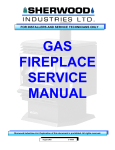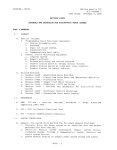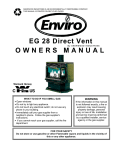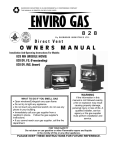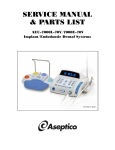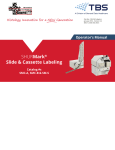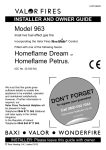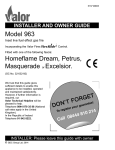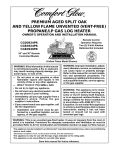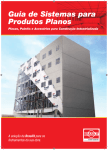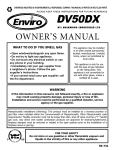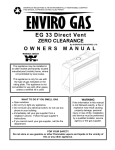Download Enviro 50-645 Owner`s manual
Transcript
SHERWOOD INDUSTRIES IS AN ENVIRONMENTALLY RESPONSIBLE COMPANY. THIS MANUAL IS PRINTED ON RECYCLED PAPER. DV42DX PLEASE KEEP THESE INSTRUCTIONS FOR FUTURE REFERENCE BY: SHERWOOD INDUSTRIES LTD OWNER’S MANUAL WHAT TO DO IF YOU SMELL GAS • Open windows/Extinguish any open flame. • Do not try to light any appliance. • Do not touch any electrical switch or use any phone in your building. • Immediately call your gas supplier from a neighbour’s phone. Follow the gas supplier’s instructions. • If you cannot reach your gas supplier, call the fire department. This appliance may be installed in an after market permanently located, manufactured (mobile) home, where not prohibited by local codes. This appliance is only for use with the type of gas indicated on the rating plate. This appliance is not convertible for use with other gases, unless a certified kit is used. WARNING If the information in this manual is not followed exactly, a fire or explosion may result causing property damage, personal injury or loss of life. Installation and service must be performed by a qualified installer, service agency or the gas supplier. FOR YOUR SAFETY Do not store or use gasoline or other Flammable vapours and liquids in the vicinity of this or any other appliance. Massachusetts installations (Warning): This product must be installed by a licensed plumber or gas fitter when installed within the Commonwealth of Massachusetts. Other Massachusetts code requirements:-Flexible connector must not be longer than 36in, shut off valve must be a “T” handle gas cock, only direct vent sealed combustion products are approved for bedroom/bathrooms, fireplace dampers must be removed or welded in the open position prior to the installation of a fireplace insert or gas log. 50-645 Safety Precautions FOR SAFE INSTALLATION AND OPERATION OF YOUR “ENVIROGAS” HEATER, PLEASE CAREFULLY READ THE FOLLOWING INFORMATION: • All ENVIRO gas-fired appliances must be installed in accordance with their instructions. Carefully read all the instructions in this manual first. Consult the building authority having jurisdiction to determine the need for a permit prior to commencing the installation. • NOTE: Failure to follow these instructions could cause a malfunction of the fireplace, which could result in death, serious bodily injury, and/or property damage. • Failure to follow these instructions may also void your fire insurance and/or warranty. GENERAL • Installation and repair should be done by a qualified service person. The appliance should be inspected before the first use and, at least, annually by a qualified service person. More frequent cleaning may be required due to excessive lint from carpeting, bedding material, etc.. It is imperative the control compartments, burners and circulating air passageways of the appliance be kept clean. • Due to high temperatures, the appliance should be located out of high traffic areas and away from furniture and draperies. Children and adults should be alerted to the hazards of high surface temperatures and should stay away to avoid burn or clothing ignition. FOR YOUR SAFETY • Installation and service must be performed by a qualified installer, service agency or gas supplier. • This installation must conform to local codes or, in the absence of local codes, to the current CAN/CGAB149 installation code (Canada) or National Fuel Gas Code ANSI Z223.1.2 (USA) • To prevent injury, do not allow anyone who is unfamiliar with the stove to operate it. • To prevent injury, if the pilot or pilot and burners have gone out on their own, open the glass door and wait 5 minutes to air out before attempting to re-light the stove. • Always keep the area around these appliances clear of combustible material, gasoline and other flammable liquids and vapours. • These appliances should not be used as a drying rack for clothing or for hanging Christmas stockings/ decorations. • Due to the paint curing on the stove, a faint odor and slight smoking will likely be noticed when the stove is first used. Open a window until the smoking stops. Always connect this gas stove to a vent system and vent to the outside of the building envelope. Never vent to another room or inside the building. Make sure the specified vent pipe is used; properly sized and of adequate height to provide sufficient draft. Inspect the venting system annually for blockage and signs of deterioration. WARNING: Failure to position the parts in accordance with the diagrams in this booklet, or failure to use only parts specifically approved with this appliance may result in property damage or personal injury. WARNING: Do not operate with the glass front removed, cracked or broken. Replacement of the glass should be done by a licensed or qualified service person. • Never use solid fuels such as wood, paper, cardboard, coal, or any flammable liquids, etc., in this appliance. • Do not use this heater if any part has been under water. Immediately call a qualified service technician to inspect the heater and to replace any part of the control or gas control systems that have been under water. • Do not abuse the glass by striking it or slamming the door shut. 2 Table of Contents Safety Precautions...................................................................................................2 Table of Contents.....................................................................................................3 Codes And Approvals................................................................................................4 Specifications.........................................................................................................5 Dimensions...................................................................................................5 Operating Instructions.............................................................................................6 Before lighting................................................................................................6 Pilot Lighting Instructions.................................................................................6 Burner lighting................................................................................................7 Remote controls..............................................................................................7 Air Diverter controls........................................................................................7 Blower speed..................................................................................................7 Maintenance And Service.........................................................................................8 Routine Maintenance......................................................................................8 Fuel Conversion.............................................................................................9 Initial Installation...................................................................................................10 Introduction.................................................................................................10 Placement....................................................................................................10 Corner Installation........................................................................................11 Raised Fireplaces and Hearths.......................................................................11 Fireplace Surround........................................................................................12 Mantle Clearances.........................................................................................13 Vent Parts and Terminal Clearances................................................................13 Vent Termination Restrictions........................................................................14 Venting........................................................................................................15 Vent Configurations and Restrictor Settings.....................................................16 Horizontal Termination..................................................................................17 Vertical Termination......................................................................................18 Ducting........................................................................................................20 Electrical System...........................................................................................21 Gas Line Connection......................................................................................22 Secondary InstallationVenting.................................................................................23 Glass Removal..............................................................................................23 Log Set and Ember Installation......................................................................23 Log Set Assembly..........................................................................................24 Pilot Light.....................................................................................................25 Venturi Adjustment.......................................................................................25 Trouble Shooting...................................................................................................26 Warranty...............................................................................................................27 Parts List...............................................................................................................28 Parts Diagram........................................................................................................29 Installation Data Sheet...........................................................................................30 Index....................................................................................................................31 3 Codes And Approvals DIRECT VENT: This type is identified by the prefix DV. This appliance draws all of its air for combustion from outside the dwelling, through a specially designed vent pipe system. ** TOP VENT DV ONLY** Certified for installation from 0-4500 FT (1372 M) This appliance has been tested and approved for installations from 0 ft. to 4500 ft. above sea level. In the USA: The appliance may be installed at higher altitudes. Please refer to your American Gas Association guidelines which state: the sea level rated input of Gas Designed Appliances installed at elevations above 2000 ft. is to be reduced 4% for each 1000 ft. above sea level. Refer also to local authorities or codes which have jurisdiction in your area regarding the de-rate guidelines. In Canada: When the appliance is installed at elevations above 4500 ft. (1350 m), the certified high altitude rating shall be reduced at the rate of 4% for each additional 1000 ft. (300 m). • These appliances have been tested by INTERTEK (Warnock Hersey) and found to comply with the established VENTED GAS FIREPLACE HEATER standards in CANADA and the USA as follows: VENTED GAS FIREPLACE HEATER (DV42DX) (NG/LPG) TESTED TO: ANSI Z21.88a.2002 CSA 2.33a.2002 VENTED GAS FIREPLACE HEATER CAN/CGA 2.17-M91 GAS FIRED APPLIANCES FOR HIGH ALTITUDES ENVIROGAS DV42DX Fireplace •Has been certified for use with either natural or propane gases. (See rating label.) •Is not for use with solid fuels. •Is approved for bedroom or bed sitting room. (Canada must install an approved wall thermostat) •Must be installed in accordance with local codes. If none exist, use current installation code CAN/CGA B149 in Canada or ANSI Z223.1/NFPA 54 in the USA. •Must be properly connected to a venting system and not connected to a chimney flue serving a separate solid-fuel burning appliance. 4 Specifications INSTALLATION OPTIONS: • • • • Parallel to a wall or placed in a corner With a floor hearth or raised up the wall Ducting to other rooms Vertical or horizontal venting WARNING: Operation of this heater when not connected to a properly installed and maintained venting system can result in carbon monoxide (CO) poisoning and possible death. DIMENSIONS: the center of the ducting hook-ups are 10in from the center of the main vent 0 2 vent has a 6 5/8in diameter gas/electrical inlets are the same on both sides Figure 1. Dimensions of the Firebox (inches) 5 Operating Instructions For Your Safety, Read Safety Precautions And Lighting Instructions Before Operating WARNING: IF YOU DO NOT FOLLOW THESE INSTRUCTIONS EXACTLY A FIRE OR EXPLOSION MAY RESULT, CAUSING PROPERTY DAMAGE, PERSONAL INJURY OF LOSS OF LIFE. BEFORE LIGHTING: This appliance is equipped with a pilot, which must be lit by following these instructions exactly: A) BEFORE LIGHTING, smell around the appliance area for gas. Smell next to the floor because some gas is heavier than air and will settle on the floor. WHAT TO DO IF YOU SMELL GAS: • Do not try to light any appliance • Do not touch any electrical switch • Do not use any phone in your building • Immediately call your gas supplier from a neighbor’s phone. Follow the gas supplier’s instructions. • If you cannot reach your gas supplier, call the fire department. B) Use only your hand to push in or turn the gas control knob. Never use tools. If the knob will not push in, or turn by hand, do not try to repair it. Force or attempted repair, may result in a fire or explosion. Call a qualified service technician. C) Do not use this appliance if any part has been under water. Immediately call a qualified service technician to inspect the appliance and to replace any part of the control system and any part of the gas system that has been under water. PILOT LIGHTING INSTRUCTIONS: The pilot light will remain on when the fireplace is in regular use, but when the fireplace is used only in certain seasons, the pilot may be extinguished during the off months. When the pilot is to be re-lit, the following steps MUST be followed. 1. STOP! Read the safety information above. 2. Turn off all electrical power to the appliance. 3 . Turn the gas control knob CLOCKWISE to the OFF position. 4. Remove the face and the glass. Wait five (5) minutes to clear out any gas. Replace the glass and face. Thermopile Thermocouple Figure 2. Pilot Flame If you smell gas, including near the floor, STOP! Follow A) in the above safety information. If you do not smell gas, continue to the next step. 5. Find the pilot in the back left side of the firebox. 6. Push in and turn the gas control knob COUNTER CLOCKWISE to PILOT. 7. Push the gas control knob in and hold. Press the piezo spark ignitor several times until the pilot lights. Keep knob depressed for about 30 seconds. If the pilot goes out, repeat steps 3 to 7. If the pilot will not stay lit after several tries, or the knob does not pop back out when released, turn the gas shut off valve to OFF and call the service technician or gas supplier. NOTE: Make sure the pilot light completely engulfs the thermocouple assembly (Figure 2) Warning: The gas valve has a lockout device that prevents the pilot burner from being re-lit until the thermocouple has completely cooled. 6 Operating Instructions For Your Safety, Read Safety Precautions And Lighting Instructions Before Operating WARNING: IF YOU DO NOT FOLLOW THESE INSTRUCTIONS EXACTLY A FIRE OR EXPLOSION MAY RESULT, CAUSING PROPERTY DAMAGE, PERSONAL INJURY OF LOSS OF LIFE. BURNER LIGHTING: A) B) C) D) E) Make sure the pilot is lit. Turn gas control knob COUNTER CLOCKWISE to ON. Flip the burner switch to ON. Turn HI/LO knob to the desired flame height. Turn on all electrical power to the unit. NOTE: Check that all burner holes are lit. TO TURN GAS FIREPLACE OFF Flip switch to OFF to turn off burners only. If the fireplace is to be turned off for the season, or for Figure 3. Control Panel servicing, turn the gas shut off valve to OFF. DO NOT FORCE IT. If the unit is going to be serviced, turn off the electrical power to the unit as well. NOTE: When the unit is turned on for the first time, it should be turned onto high, with the fan OFF, for the first four hours. This will cure the paint, logs, gasket material, and other products used in the manufacturing process. It is advised that a door or window be opened as the unit will start to smoke, which can irritate some people. After the unit has gone through the first burn, turn the unit OFF, including the pilot, and let the unit get completely cold. Then remove the glass and clean it with a good gas fireplace glass cleaner, available at your local Envirogas dealer. See page 23 for glass removal and page 8 for glass cleaning information. REMOTE CONTROLS: This fireplace can use an optional remote control or an optional cordless wall thermostat. If either of these are to be used to control the fireplace for the majority of the time, leave the ON/OFF switch (on the control panel) in the remote/thermostat position. Consult the instructions included with the remote/wall thermostat for operation guidelines. AIR DIVERTER CONTROL: When the blower is on, the amount of air flow into the room can be ajusted with the air diverter. when the lever is to the far left the room receives the air, when the lever is to the far right the air goes out the duct and when the lever in the middle the air goes to both the duct and the room. Lever is found above the right end of the control panel, see figure 4. BLOWER SPEED: Room Air Diverter Duct Figure 4. Air Diverter The blower will come on only when the fireplace is up to temperature (approx 20 minutes). The speed of the fan can be changed by turning the fan control knob. To turn the blower off, turn the knob COUNTER CLOCKWISE until it “clicks” off (Figure 5). It is advisable not to operate the blower below 1/3 speed as it puts a strain on the windings of the blower and running the blower at lower speeds could also cause premature fan failure. Figure 5. Fan Control 7 Maintenance And Service ROUTINE MAINTENANCE: At least once a year, run through the following procedures to ensure the system is clean and working properly. Check the burner to see if all the ports are clear and clean. Check the pilot to make sure it is not blocked by anything. The pilot flame should be blue with little or no yellow on the tips. CLEANING THE GLASS: When the fireplace is cool, remove the face of the fireplace along with the glass. See Secondary Installation. Check the gasket material on the back of the glass, making sure that it is attached and intact. During a cold start up, condensation will sometimes form on the glass. This is a normal condition with all fireplaces. However, this condensation can allow dust and lint to cling to the glass surface. Initial paint curing of the appliance can leave a slight film behind the glass, a temporary problem. The glass will need cleaning about two weeks after installation. Use a mild glass cleaner and a soft cloth. Abrasive cleaners will damage the glass and plated surfaces. Depending on the amount of use, the glass should require cleaning no more than two or three times a season. Do not clean the glass when it is hot. CLEANING THE FIREBOX: Remove the logs carefully, as they are very fragile. Gently remove all the embers and rock wool and place on a paper towel. Vacuum the bottom of the firebox thoroughly. Carefully clean any dust off the logs and remove any lint from the burner and pilot. At this time, inspect the burner pan for cracking or severe warping. If a problem is suspected, contact the dealer. Replace the logs and ember as in Secondary Installation. REPLACING GLASS: The glass in the fireplace is a high temperature ceramic. If the glass is damaged in any way, a factory replacement is required (see Parts List). Wear gloves when handling damaged glass door assembly to prevent personal injury. When the glass door assembly is being transported, it must be wrapped in newsprint and tape and/or a strong plastic bag. Do not operate with the glass front removed, cracked or broken. Removal and replacement of the glass from the door must be done by a licensed or qualified service person. The glass must be purchased from an ENVIRO dealer. No substitute materials are allowed. CLEANING THE FACE: Painted and porcelain faces should be wiped with a damp cloth periodically. If a plated face has been purchased, it should be unpacked/unwrapped carefully to avoid getting anything on the surface of the finish, including cleaners, polish and finger prints. It is important to note that fingerprints and other marks can leave a permanent stain on plated finishes. To avoid this, give the face a quick wipe with denatured alcohol on a soft cloth BEFORE lighting the fireplace. Never clean the face unless it is cool. Do not use other cleaners as they may leave a residue, which can become permanently etched into the surface. If your fingers come into contact with the antique copper finish, the oils left as fingerprints on the copper can cause discoloration, which will eventually turn green in that area. You can clean the patina or discolored areas of the antique copper finish with “OO” 3M green sanding pads. These can be purchased from most hardware stores. On the areas with discoloration, use the sanding pads to sand in the same direction as the brushed finish, then blend the finish by feathering in the surrounding area. This refinishing procedure has been approved by the manufacturer and will not harm the finish. Please note: ANTIQUE COPPER IS THE ONLY FINISH THAT CAN BE SANDED, DO NOT SAND PEWTER, GOLD OR NICKEL FINISHES. Warning: Clearances must be sufficient to allow access for maintenance and service Warning: Failure to position the parts in accordance with this manual, or failure to use only parts specifically approved with this appliance may result in property damage or personal injury. 8 Maintenance And Service FUEL CONVERSION: Warning: A qualified service technician, in accordance with the manufacturer’s instructions as well as all applicable authority having jurisdiction, shall install this conversion kit. If the information in these instructions is not followed exactly, a fire, explosion or CO poisoning, may result. The qualified service agency is responsible for the proper installation of this kit. The installation is not proper or complete until the operation of the converted appliance is checked as specified in the owner’s conversion kit. Please read and follow these instructions. Also, please read the instruction guidelines provided by S.I.T. on how to remove and install the HI/LO regulator. Step 1. Carefully inspect all parts supplied with this conversion kit. Step 2. Shut the gas off at the shut off valve. Step 3. Remove the glass as shown in the Secondary Installation section. Step 4. Change the regulator on the front of the gas valve (Follow the instructions provided by S.I.T.) Step 5. To change the pilot, simply pull the pilot hood straight up to access the pilot injector. Using a 5/32in Allen key, remove the pilot injector. Step 6. Install the new pilot injector supplied with this conversion kit. Simply screw the new injector inside the pilot hood and reinstall the hood by placing the hood on the assembly, lining up the key way, and snap into place. Step 7. Remove the main burner orifice with a 1⁄2in deep socket. Step 8. Install the new orifice supplied. Be sure to put a bead of pipe thread sealant or approved Teflon tape on the orifice before installing into the burner assembly. Step 9. Reinstall the burner tray, log set, embers, and glass. Step 10. Open shut off valve at the gas line to the unit. Step 11. Re-light the fireplace to ensure proper operation and proper flame appearance. Step 12. MAKE SURE that the sticker provided by S.I.T. is installed, to signify that the valve has been converted to a different fuel type. Also, make sure that the rating plate has a conversion label to show this unit has been converted to a different fuel type. A VISUAL CHECK OF THE REGULATOR KNOB IS NECESSARY TO DETERMINE WHETHER OR NOT THE REGULATOR IS THE CORRECT PART. A 50% TURN DOWN REGULATOR WILL HAVE ONLY ONE CORNER ON THE KNOB Conversion Kits should contain the following: 1 50% turn down HI/LO regulator with 3 T-20 Torx screws 1 Pilot injector 1 Main orifice Conversion instructions Labels to show conversion Pilot Orifice: Burner Orifice: NATURAL GAS 2.82mm #34 DMS PROPANE GAS 1.70mm #51 DMS 9 Initial Installation QUALIFIED INSTALLERS ONLY INTRODUCTION: This section of the owner’s manual is for the use of qualified technicians only. Fireplace placement, hearths, facings, mantles, and venting terminations will be covered, as well as the gas and electric systems. There are several installation safety guidelines that must be adhered to. Please carefully read the safety precautions at the front of this manual. PLACEMENT: The location for the fireplace can be along a wall, raised or at floor level, or in a corner. There are specific framing measurements for each situation. The basic opening should have the dimensions shown below in Figure 6. Figure 6. Dimensions for Framing the Firebox (inches) The fireplace must have a strong and level surface to be placed on. The surface should be made of wood or a noncombustible material, not carpet. The 19 7/16in (49.4cm) dimension takes into account the 1in (2.5cm) standoff on the back of the firebox. The framing boards may touch the standoffs, but no insulating material can be placed between the frame and the standoffs. The gas line, 3/8in MPT, should be brought to the right side of the fireplace. If this set up is inconvenient, the electrical wire and the gas line configuration can be reversed. The location should be chosen so the fireplace will be at least 36in from drapes, doors and other combustibles. The fireplace opening should also be at least 5in from the nearest perpendicular wall. 10 Initial Installation QUALIFIED INSTALLERS ONLY CORNER INSTALLATION: The dimensions for installing a fireplace in the corner of a room are given below in Fig 7. Figure 7. Dimensions for a corner installation (inches) RAISED FIREPLACES AND HEARTHS: There are a few options with raised fireplaces: raised with no hearth, raised with a raised hearth, or raised with a floor level hearth. If the fireplace is 3in (7.6cm) or more above the floor, a hearth is not required. This measurement should be taken from the top of the flooring, i.e. the top of the carpet. The fireplace cannot be placed within 41in of the ceiling. When installing a raised fireplace, it is imperative that the support stand is strong enough to hold the weight of the fireplace and venting. Figure 8. Raised Fireplace with no Hearth Figure 9. Raised Fireplace with Floor Level Hearth 11 Initial Installation QUALIFIED INSTALLERS ONLY Do not tile higher than this ledge Protector pad, cement board and finishing material. Protector Pad Figure 10. Raised Fireplace with Raised Hearth Cement board Figure 11. Floor Level Hearth Requirements If a hearth is to be installed, the protector pad (sheet metal) is placed directly on the floor or hearth framing, with the cement board on top of it. Tile, or another non-combustible material forms the top layer of the hearth. A decorative trim may be added to the edge of the hearth. The trim can be combustible as long as the hearth extends at least 12in (30cm) in front of the fireplace and 1in (2.5cm) on either side of the fireplace opening. To install the face, it is necessary for the bottom flange of the fireplace opening to overlap or be flush with the tile. If the total thickness of the protector pad, cement board, and finished tile is more than 1” (2.5cm) the fireplace must be raised to accommodate additional thickness. Cement board for the hearth can be purchased at a local building material store, the board must have a k-value of 7.69 Btu/(ft2 × h × °F) (13 W/m × K) and a R-value of 0.13 ft2 × h × °F/Btu (0.023 m2 × K/W) or better. NOTE: The Manor (the cast iron) face does NOT require any floor protection even when installed at floor level. FIREPLACE SURROUND: NOTE: Any paint that is applied to the mantel or facing above the unit should be “heat resistance” or it may discolour. TILED FINISH: Because of the amount of heat exuded by the fireplace, drywall cannot come directly up to the fireplace. Figure 12 shows the minimum dimensions for the cement board. Tile or other non-combustible materials cover the cement board, but do not overlap into the fireplace opening. The total depth of the cement board and the finishing materials should be a minimum of 1in (2.5cm) to maximum of 1 3⁄8in (3.5cm). The fireplace front will be installed over top of the finishing material. SMOOTH FINISH: The fireplace will have to be recessed by 1⁄2in (1.3cm) and 2 layer of cement board must be used if the area around the fireplace will be finished flush with the rest of the wall. Figure 12. Dimensions Facing Around Opening (inches) 12 ROCK OR BRICK FINISH: If the face of the fireplace is to be recessed, the face option chosen will determine the size and shape of the surrounding material (i.e. brickwork). Since the dimensions provided on the face option instruction sheet are only approximations it is recommened that the steel template of the chosen face is used. See Parts List for the face template part number. Initial Installation QUALIFIED INSTALLERS ONLY MANTLE CLEARANCES: It is not necessary to install a mantle, but if one is desired it is important to follow the guidelines. The Manor face has a different set of clearances than the other faces. 8in mantle 3 1/12in mantle 8in mantle Figure 13. Combustible Mantle Clearances (inches) Figure 14. Combustible Mantle (inches) Clearances for The Manor VENT PARTS AND TERMINAL CLEARANCES: SIMPSON DURAVENT (SD) and METALBESTOS (M), must state if galvanized or black wanted, PART NUMBERS: SD M Description SD 908 1604006 6” pipe length 943S 907 1604009 9” pipe length 953 1604810 Storm collar 906 1604012 12” pipe length 963 1604500 Fire stop 904 1604024 24” pipe length 988 1604430 Wall support 903 1604036 36” pipe length 984 902 1604048 48” pipe length 11” to 14 5/8” pipe, adjustable, black 971 911 M Description Flashing, 7/12 to 12/12 roof pitch Horizontal square termination 1604621 980 Horizontal termination kit A Vertical termination 1604082 4”-10” pipe , adjustable 991 1604802 High wind vertical termination 945 1604215 45° elbow, black 985 1604804 High wind horizontal termination 990 1604230 90° elbow, black 1604808 Vinyl siding shield plate 1604825 Flashing, 0/12 to 6/12 roof pitch 950 1604806 Vinyl siding standoff 1604830 Flashing, 6/12 to 12/12 roof pitch 942 1604460 Wall thimble 943 Flashing, 0/12 to 7/12 roof pitch The Sherwood Home Collection of fireplaces have been tested and certified for use with SIMPSON DURAVENT TYPE GS PIPE FOR GAS STOVES. SECURITY CHIMNEY’S “SECURE VENT DIRECT VENT SYSTEM” and SELKIRK “METALBESTOS MDV VENT SYSTEM” kits are available for horizontal venting. When using Simpson Duravent, it is recommended that, before installation, a bead of RTV High Temperature Silicone should be applied to each outer 13 Initial Installation QUALIFIED INSTALLERS ONLY vent joint, and Mil-Pac to each inner joint. When planning an installation it will be necessary to select the proper length of vent pipe for the particular requirements. It is important to note that, when passing a pipe through a wall, 11⁄2in clearance on the sideds and bottom, and 2in top clearance to combustibles must be maintained. H D E L B C B B Fixed Closed F G Fixed Openable Closed Openable B A Termination Cap G M J Air Supply Inlet G Gas Meter K I Restriction Zone A (Termination not allowed) Figure 15. Vent Termination Restrictions Letter Canadian Installation 1 A B US Installation2 12in (30cm) 12in (30cm) Description Clearance above grade, verandah, porch, deck, or balcony. 9in (23cm) Clearance from window or door that may be opened. C 12in (30cm)* Clearance from permanently closed window (to prevent condensation). D 24in (60cm)* Vertical clearance to ventilated soffit located above the terminal within a horizontal distance of 2 ft (60cm) from center line of terminal. E 18in (45cm)* Clearance to unventilated soffit. F 12in (30cm)* Clearance to outside corner. G 12in (30cm)* Clearance to inside corner. H 3ft (91cm) within a height of 15ft (4.5m) above the meter/ regulator assembly 3ft (91cm) within a height of 15ft (4.5m) above the meter/ regulator assembly* Clearance to each side of center line extended above meter/regulator assembly. I 3ft (91cm) 3ft (91cm)* Radially clearance around service regulator vent outlet. J 12in (30cm) 9in (23cm) Clearance to non-mechanical air supply inlet to building, or the combustion air inlet to any other appliance. K 6ft (1.83m) 3ft (91cm) above if within 10ft (3m) horizontally L 7ft (2.13m)t 7ft (2.13m)*t Clearance above paved sidewalk or paved driveway located on public property M 12in / 30cm+ 12in / 30cm*+ Clearance under verandah, porch, deck, or balcony Clearance to mechanical air supply inlet 1 In accordance with the current CSA B149, Natural Gas and Propane Installation Code. 2 In accordance with the current ANSI Z223.1 NFPA 54, National Fuel Gas Code. * These numbers are only estimates. Clearance in accordance with installation codes and the requirements of the gas supplier. t A vent shall not terminate directly above a sidewalk or paved driveway that is located between two single family dwellings and it serves both dwellings. + Permitted only if verandah, porch, deck, or balcony is fully open on a minimum of two sides beneath the floor. NOTE: Venting terminals shall not be recessed into walls or siding. 14 Initial Installation QUALIFIED INSTALLERS ONLY VENTING: This fireplace has been tested and certified for use with SIMPSON DURAVENT DIRECT VENT TYPE “GS” PIPE FOR GAS STOVES, SECURITY CHIMNEY’S SECURE VENT DIRECT VENT SYSTEM kits, and MDV SELKIRK METALBESTOS. A 1in (2.5cm) clearance to combustibles must be maintained around any vertical vent pipe. Around a horizontal vent pipe, the clearance to combustibles should be 2in (5cm) above and 1 1/2in (3.75cm) on the sides and bottom. When combustible materials are directly above a 90° elbow, 4in (10cm) of clearance are necessary. A 10in (25cm) x 10in (25cm) frame will assure the proper support and spacing for the vent pipe as it passes through the wall. Installations in Canada require that a wall thimble be used for passing through walls and ceilings. See Figure 17. All sealing and vapour barriers must comply with local building codes. When planning an installation, it is necessary to select the proper length of vent pipe for the particular requirements. The configuration of the venting pipes depends on the locations of walls, ceilings and studs. However, the pipes cannot be of arbitrary length and arrangement. Because the length of the vertical and horizontal sections dramatically affects the burning efficiency of the fireplace, certain guidelines have been set. Venting terminals can not be recessed into a wall or siding WARNING: This gas appliance must not be connected to a chimney flue serving a separate solid-burning appliances. Figure 16. Vent Pipe Clearances (inches) Figure 17. Vent Framing Through Wall/Ceiling 15 Initial Installation QUALIFIED INSTALLERS ONLY VENT CONFIGURATIONS AND RESTRICTOR SETTINGS: Fig 18 shows the range of venting options. Any layout that remains within the shaded area of Figure 18 is acceptable. Having the fewest number of elbows is ideal, as they tend to disrupt air movement. Using 45˚ elbows is preferable to using 90˚ elbows. Also, a shorter vent system will perform better than a longer one. The vent restrictor controls the amount of air moving through the vent pipe. Longer vertical vent lengths necessitiate greater restraint. Figure 18 shows the vent restrictor settings required, relative to the length of vent pipe. The vent restrictor is located on the right side of the fireplace, above the glass. Figure 18 shows the vent restrictor handle and the holes that indicate the different levels. To avoid injury it is best to make this adjustment when the fireplace is cool or use welder’s gloves or oven mitts. Vent Restrictor Positions 5 4 3 2 1 Vent Restrictor Figure 19. Possible Vent Configurations Figure 18. Possible Vent Configurations 16 Initial Installation QUALIFIED INSTALLERS ONLY HORIZONTAL TERMINATION: Step 1. Set the fireplace in the desired location. Check to determine if wall studs will be in the way when the venting system is attached. If this is the case, the location of the fireplace may have to be adjusted or the venting may have to be offset. Step 2. Direct vent pipe sections are designed with special twist-lock connections. Dry fit the desired combination of pipe and elbows to the appliance adapter. Step 3. With the pipe in the correct position and attached to the fireplace, mark the wall for a 10in x 10in square hole. The center of the hole should match the center line of the horizontal pipe. Cut and frame the hole in the exterior wall where the vent will be terminated. If the wall being penetrated is made of a non-combustible material (i.e. masonry or concrete), a 7in hole is acceptable. NOTE: For Simpson Duravent only, place a bead of Mil-Pac on the outer edge of the inner exhaust pipe (nonFigure 20. Horizontal Vent Termination flared end). Push the pipe sections together, then twist about 1⁄4 turn, making sure the two sections are fully locked. Wrap all seams with foil ducting tape. This method makes disassembly easy and reassembly can be done the way it was origianally assembled. Step 4. With the hole now framed, the wall thimble installed and the pipe extending into the wall, proceed to the outside. Attach the termination to the pipe using RTV and MilPac to seal joints. The vent pipe must extend into the vent cap at least 11⁄4”. Secure the connection between the vent cap and the pipe by attaching the two sheet metal straps, which extend from the vent cap assembly to the outerwall of the vent pipe. Bend any remaining portion of the strap back towards the vent cap. Step 5. Run a bead of non-hardening mastic around the edges of the vent cap, to make a seal with the wall. Position the horizontal vent termination in the center of the 10in square hole and attach to the exterior wall with the four screws provided. The arrow on the vent termination should be pointing up. Ensure the proper clearances to combustibles have been maintained (see page 14). See page 18 for important notes. 17 Initial Installation QUALIFIED INSTALLERS ONLY NOTES: 1. Horizontal pipes must not be level. For every 12in (30cm) of horizontal travel (away from the stove), there should be at least 1/4in (6mm) of vertical travel. Never allow the vent to run downward, as this could cause high temperatures or even present the possibility of a fire. 2. The exterior of the horizontal vent termination must not be blocked or obstructed. 3. If the vent termination is not being attached to wood, the four wood screws provided should be replaced with material appropriate fasteners. 4. For buildings with vinyl siding, a vinyl standoff should be installed between the vent cap and the exterior wall. Attach the vinyl siding standoff to the horizontal termination. Note that the termination bolts onto the flat portion of the standoff, providing an air space between the wall and the vent termination. The air gap prevents excessive heat from possibly melting the vinyl siding. 5. Horizontal pipes must be supported every 3ft. Plumber’s all round strap will suffice. 6. When running horizontal pipe, clearances to combustibles must be maintained (11⁄2in (3.8cm) sides, 11⁄2” (3.8cm) bottom, and 2” (5.1cm) top) VERTICAL TERMINATION: Step 1. Check required clearances to combustibles when passing through ceilings, walls, roofs, enclosures, or attic rafters. See end of this section. Do not pack air spaces with insulation. Step 2. Set the fireplace in the desired location. Drop a plumb bob down from the ceiling to the flue exit. Mark the location where the vent will penetrate the ceiling and drill a small hole at this point. Next, drop a plumb bob from the roof to the hole drilled in the ceiling. Mark the spot where the vent will pass through the roof. Determine if the ceiling joists, rafters or other framing members will obstruct the venting system. The fireplace may need to be relocated to avoid cutting any load bearing members or an offset elbow can be used. Step 3. To install the wall thimble in a flat ceiling, cut a 10in (25.4cm) x 10in (25.4cm) x 10in square hole in the ceiling. The previously drilled hole should be at the center of the new hole. The square hole should be framed. See Figure 17. pipe support strap Step 4. Assemble the desired lengths of pipe and elbows necessary to reach through the square hole from the fireplace adapter. Ensure all the pipe and elbow connections are fully twisted and locked together. Step 5. Cut a 10in (25.4cm) x 10in (25.4cm) hole in the roof, centered on the small hole cut previously. Continue to assemble lengths of pipe necessary to reach from the ceiling support box up through the roof line. 18 Figure 21. Vertical Vent Termination Initial Installation QUALIFIED INSTALLERS ONLY Step 6. Once the pipe sections have been joined and run up through the roof, slip a pipe support strap over the exposed sections. Bend the support straps outwards and push the pipe support strap down to the roof level. Use a level to make sure the pipe is vertical and tighten the clamp around the pipe section. With roofing nails, secure the support straps to the roof and seal the nail heads with non-hardening mastic. Trim the excess length of the straps. If the installation is taking place in a finished house the pipe support straps can be attached to the rafters in the attic. See figures 21 and 22. Step 7. Slip the flashing over the pipe section protruding from the roof and secure the base of the flashing with roofing nails. Use a non-hardening sealant on the nail holes and the edges of the flashing. On a sloped roof, make sure the shingles overlap the top edge of the flashing. Step 8. Continue to add pipe sections until the height of the vent cap meets the minimum code requirements (see Table 1). In high winds, nearby trees, adjoining roof lines, steep roof pitches, and other similar factors can result in poor draft or down drafting. In these cases, increasing the vent height may solve the problem. Step 9. Slip the storm collar over the pipe and push it down to the top of the flashing. Use the non-hardening sealant around the joint between the pipe and the storm collar. Step 10. Twist on the vent cap until it locks. NOTES: 1. If an offset is necessary to avoid obstructions in the attic, the vent pipe must be supported every 3ft (91.4cm) (see figure 22). 2. Whenever possible, use two 45° elbows rather than two 90° elbows, as the 90° elbows tend to restrict the flow of flue gases. plumber’s strap 3. For multi-story installations, a ceiling fire stop is required at the second floor and any subsequent floors. The opening should be a framed 10in (25.4cm) x 10in (25.4cm) hole. 4. Any areas above the first floor, including closets and storage spaces which the vent passes through, must be enclosed. The enclosure can be framed and sheet rocked with standard building materials. All minimum clearances must be maintained. Do not fill any of the required air spaces with insulation. Figure 22. Pipe Support 19 Initial Installation QUALIFIED INSTALLERS ONLY Table 1. Minimum Distance Associated with Roof Pitch ROOF PITCH MIN DISTANCE ft m flat to 7/12 1 0.3 >7/12 to 8/12 1.5 0.46 >8/12 to 9/12 2 0.61 >9/12 to 10/12 2.5 0.76 >10/12 to 11/12 3.25 0.99 >11/12 to 12/12 4 1.22 >12/12 to 14/12 5 1.52 >14/12 to 16/12 6 1.83 >16/12 to 18/12 7 2.13 >18/12 to 20/12 7.5 2.29 >20/12 to 21/12 8 2.44 DUCTING: The option of ducting allows heat from the fireplace to be transferred to a different area. The maximum total length for the ducting is 20ft (6.1m). There are four duct outlets that can be used, however, the blower puts out 200cfm no matter how many ducts are used. Therefore, the more ducts there are, the less air goes through each one. A short, straight duct maximizes its’ heating ability as air in the ducts is restricted by the length and number of bends in the pipe. For the first 24in (61cm) of ducting, 1/2in (1.3cm) of clearance is required. After 24in (61cm), the duct can be run with 0in clearance, though 1/2in (1.3cm) is preferred. To avoid heat loss, insulate the duct whenever it passes through an unheated area (i.e. crawl space). Insulating the ducts elsewhere helps the efficiency of the ducting system. Standard galvanized ducting and heat registers are to be used. Simply remove the desired cover plate from the outside of the firebox and attach a 6in (15.2cm) starter ring. Make sure to foiltape all seams to prevent leaking. Ensure all ducting meets local building codes. Figure 23. Ducting Options; ducted from upper floor to lower floor & from lower floor to upper floor. 20 Figure 24. More Ducting Options; ducted to outside & to another room on an interior wall. Initial Installation QUALIFIED INSTALLERS ONLY ELECTRICAL SYSTEM: The fireplace must be electrically connected and grounded in accordance with local codes or, in the absence of local codes, with the current CSA C22.1 CANADIAN ELECTRICAL CODE Part 1, SAFETY STANDARDS FOR ELECTRICAL INSTALLATIONS, OR THE NATIONAL ELECTRICAL CODE ANSI / NFPA 70 in the US. WARNING: The electrical grounding instructions must be followed. This appliance is equipped with a three-prong (grounding) plug for your protection against shock hazard, and should be plugged directly into a properly grounded three-prong outlet. DO NOT cut or remove the grounding prong from this plug. CAUTION: When servicing controls, label all wires prior to disconnection. Wiring errors can cause improper and dangerous operation. Verify proper operation after servicing. Recommended Thermostat Wire Size: Figure 25. Wiring Diagram For Fan Control. Wire Size Max. Length 14 ga. 100 ft (30.48m) 16 ga. 60 ft (18.29m) 18 ga. 40 ft (12.00m) 20 ga. 25 ft (7.62m) 22 ga. 18 ft (5.49m) O O N FF 70 ° F 70 ° F UP DOWN COOL / HEAT PROGRAM Figure 26. Wiring Diagram For Gas Valve. 21 Initial Installation QUALIFIED INSTALLERS ONLY GAS LINE CONNECTION: Warning: Only persons licensed to work with gas piping may make the necessary gas connections to this appliance. Gas Line Connection: • This fireplace is equipped with a certified flexible pipe located on the right side of the unit, terminating in a 3/8in male NPT fitting. Consult the local authorities for local codes or use the CAN/CGA B149 (1 or 2) installation code in Canada. In the US, gas installations follow either local codes or the current edition of the National Fuel Gas Code ANSI Z223.1. • The efficiency of this unit is a product thermal efficiency rating determined under continuous operating conditions and was determined independently of any installed system. The appliance and its’ shut-off valves must be disconnected from the gas supply piping system during any pressure testing where the pressure exceeds 1/2 psig (3.45kPa) or the valve will be damaged. The unit must be isolated from the gas supply piping system by closing its’ individual manual shut off valve during any pressure testing of the gas supply piping system at pressures equal to or less than 1/2psig (3.45 kPa) Always check for gas leaks with a soap and water solution after completing the required pressure test. Figure 27. Gas Control Assembly TO TEST VALVE PRESSURES: Main Burner Natural Gas (in wc/kPa) Propane Gas (in wc/kPa) right of the valve. Figure 27. Orifice: #34 DMS #51 DMS • Turn set screw 1 turn counterclockwise to loosen. Manifold Press: 3.8 / 0.95 11.0 / 2.74 • Place 5/16in (8mm) I.D. hose over the pressure Min. Manifold Press: 1.1 / 0.27 2.7 / 0.67 The pressure taps are located on the top Max. Supply Press: 7.0 / 1.74 13.0 / 3.28 • Check pressures using a manometer. taps. Min. Supply Press: 5.0 / 1.24 12.0 / 2.98 • When finished, release pressure, remove hose Max. BTU Input: 38,000/11.34kWh 34,500/10.11kWh Min. BTU Input: 20,000/ 5.86kWh 18,000/ 5.28kWh and tighten set screw. Table 2. Gas Rating NEVER USE AN OPEN FLAME FOR LEAK TESTING 22 Secondary Installation GLASS REMOVAL: In order to install the log set, and for regular cleaning, the glass door will need to be removed. With the face off, there are two handles on either side of the glass. They rotate 90° until parallel with the floor. The top of the glass will glass move away from the firebox and then the glass door can be lifted off the resting points. To replace the glass door, simply reverse the above procedure. Warning: Do not touch or attempt to remove the glass if the fireplace is not completely cold. WARNING: Never operate the fireplace with the glass removed. Figure 28. Glass Removal Handle LOG SET AND EMBER INSTALLATION: The placement of the logs is not arbitrary. If they are positioned incorrectly, the flames can be “pinched” and will not burn correctly. The burner and a few of the logs come with locator pins, which make alignment easier. Using the pictures provided, carefully set the logs in place (see figures 29 thru 34). NOTE: The logs are fragile and should be handled gently. When removing the logs from their packaging be careful and check that there are 5 large logs (back, left/center, left, right, and center) and 2 small pieces before discarding of the packaging. One log may be covered by cardboard. Maintenance: Once a year the logs should be removed and checked for deterioration or large amounts of soot. A small amount on the bottom side of the logs is normal. Remove and replace the logs in the same manner described above. If new/more embers and rock wool is required, contact your nearest ENVIRO dealer. Never operate the fireplace with the glass door removed. 23 Secondary Installation LOG SET ASSEMBLY: Figure 29: Shows the back log plus the two small log twigs. Put the large back log in first, making sure the locator pins line up with the cutout sections on the log. There are two pins with ledges and a single ledge on the back log. The back log sits on two supports attached at the rear of the firebox. The two small twigs are placed under the grate and they should be rotated so they cover up the least number of small burner ports. Figure 29: First Stage Log Set Installation. Figure 30: Shows the left/center log in place. The left/center log is placed on the other two pins connected to the burner pan and the straight part rests on the grate connecting the andirons. There are notches on the bottom of the left/center log to help position the log correctly. Figure 30: Second Stage Log Set Installation. Figure 31: The right log rests on the right pin and ledge of the back log and the floor of the firebox. Figure 31: Third Stage Log Set Installation. 24 Secondary Installation Figure 32: The left log rests on the left pin and ledge of the back log and the back of the andiron. Figure 32: Fourth Stage Log Set Installation. Figure 33: The last log, center log, rests on the end of the grate and on the ledge cut-out in the center of the back log. Once the logs are in place the embers can be installed. Bags of ceramic fiber embers and rock wool are provided. The ceramic fiber comes in chunks that are about 2in (5cm) long. Place them irregularly around the burner. When there is a sparse but even layer of embers, spread the rock wool in the same manner. DO NOT pack the rock wool material as this could create an unsafe condition. The pieces should be lightly placed so they don’t completely block any of the tiny ports. DO NOT allow any of the embers to rest against the pilot assembly. Figure 33: Final Log Set Arrangement with Embers. Caution: Use only the type of ember material supplied with this fireplace. Due to the irregular size of the ember material, there may be more than required. Use of other foreign materials on the burners may create dangerous conditions. Figure 34: Refer to this figure when adjusting the venturi and vent restrictor. Make adjustments so that the flame reaches the approximate height shown NOTE: While the glass is still removed, it is recommended that the gas line be purged by lighting the pilot. Figure 34: DV42DX Burning. When lighting the fireplace for the first time since the log set and embers have been installed/ replaced, watch for ignition at ALL the burner ports. If a long delay is noticed, turn the appliance off and wait for it to cool down. Then remove the glass and rearrange the ember material, making sure none of the burner ports are blocked. 25 Secondary Installation PILOT LIGHT: 1. Turn off the gas to the fireplace. If not recently done, remove the glass and let the unit air out for at least five (5) minutes to clear out any gas. Turn on gas to the heater. Leak test all joints with soapy water. NEVER USE OPEN FLAME FOR LEAK TESTING. 2. Start the pilot by pressing the gas control knob and turning it to PILOT. While holding the gas control knob in, press the piezo ignitor several times until the pilot light starts. Keep holding the gas control knob in for 30 seconds. Check that the pilot has fully engulfed the thermocouple assembly. See Figure 2. 3. Start the main burner by turning the gas control knob to ON and then turn the rocker switch to ON. Check that all burner ports have flame. 4. Leak test all gas joints again. VENTURI ADJUSTMENT: The venturi adjustment lever is centered above the control panel. The venturi allows the amount of air coming into the fireplace to be adjusted in order to accommodate different climates and venting arrangements. Start the pilot and then the burner. Make sure the pilot flame is burning normally and none of the burner ports are plugged. Let the fireplace burn for roughly fifteen minutes and then examine the flames. The ideal flame will be blue at the base and light orange above. The flames should be of medium height. If the flames look like this, no venturi adjustment is needed. If the flames are fairly short and mostly blue, the fireplace is getting too much air. Therefore, the air shutter should be closed (push in) slightly until the correct flames are achieved. Flames that are very orange, with tall dark stringy tips are not getting enough air. Open (pull out) the venturi until the flames clean up. If the venturi is opened, then closed all the way, and the correct flames cannot be attained, turn off the gas and contact the dealer. Figure 35. Venturi Adjustment Lever Warning: Incorrect venturi adjustment may lead to improper combustion, which is a safety hazard. Contact the dealer if there is any concern about the venturi adjustment. NEVER USE AN OPEN FLAME FOR LEAK TESTING 26 Trouble Shooting Problem Possible Cause Solution Spark will not light the Defective piezo ignitor pilot after repeatedly pressing the spark ignitor Pilot will not remain lit • Check connections to ignitor. • If ignitor connections are good but no spark, replace ignitor. Broken spark electrode • Check for broken ceramic insulation, replace electrode if broken. Misaligned spark electrode • If spark is not arcing from electrode to pilot, adjust by loosening the screws on the pilot base. Adjust and tighten. Problem with thermocouple • Check for proper connection of the thermocouple to circuit the rear of the valve; if loose fully tighten. • Check pilot for full flame impingement around thermocouple. If flame is too small, check gas pressure, adjust pilot rate screw, check pilot head for damage. • Check thermocouple voltage at valve. It must be greater than 5mV. If low, replace thermocouple. Air in gas line (pilot dies • Bleed line. while knob is depressed) • Check gas line pressure. • Contact dealer. Burners will not remain Problem lit circuit Flame lifting with thermopile • Check gas line pressure . • Check for flame impingement in thermopile. If low, see “Pilot will not remain lit”. • Check thermopile for minimum of 300mV when burner is switched on. • Check wiring to thermostat for breaks. Leak in vent pipe • Check for leaks in vent connections. Improper vent configuration • Check vent configuration with manual. Terminal may recirculating flue gases be • Check to see if terminal is on correctly. • May need to install high wind termination cap. • Contact dealer. Glass fogs up Normal Condition: after the appliance warms up the glass will clear. **Due to additives in gas, glass may get hazy during operation** Clean as needed. Blue Flames Normal during start up: flames will yellow as the fireplace heats up. Flames are burning “dirty” Flame impingement or sooting • Check log positioning. • Increase primary air by opening the venturi shutter and/or by opening the vent restrictor. See also “Burners will not stay lit”. Remote control doesn’t Problem with the remote work • One or more of the batteries are dead. See remote control instructions. Problem with fireplace • The on/off switch is turned to OFF. • The gas control valve is turned to PILOT or OFF. • The pilot has gone out. 27 Parts List 28 Part Description Number Part Options Number 50-633 Door, Glass & Gasket 50-534 50-634 Dual bulb door gasket (10ft) The Lodge - Painted Charcoal Face With Plated Brushed Nickel Louvres & Knobs 50-635 Door Handle Set 50-537 The Manor Cast Iron Bay Face - Painted 50-632 Door Latch Mechanism 50-539 50-629 Pan Burner The Manor Cast Iron Bay Face - Diamond Black 50-343 Blank Orifice #73 - All Gas Models 50-541 EC-011 Spark Electrode with Ignitor Cable (Post 10/00) The Chalet Painted Flat Arched Face Metallic Charcoal 50-542 The Chalet Plated Flat Arched Face - Gold EC-023 S.I.T. Piezo Ignitor 50-543 EC-025 FS Burner Switch The Chalet Plated Flat Arched Face Brushed Nickel EC-039 FPI Fan Controller 115V 50-608 50-636 Control Panel The Chalet Plated Flat Arched Face Anitque Copper EC-015 Fully Assembled Pilot NG 50-693 The Cottage Bow Face Painted Charcoal - (No Trim) EC-016 Fully Assembled Pilot LP 50-548 EC-012 Thermopile EC-009 Thermocouple (Post 10/100) The Cottage Trim Kit - Gold (2 Inset Pieces, Carriage Bolts, Top & Bottom Trim Pieces) EC-006 S.I.T. Nova Valve NG (50% turn down) 50-549 EC-007 S.I.T. Nova Valve LP (50% turn down) EC-001 120 Ceramic Fan Temperature Sensor The Cottage Trim Kit - Pewter (2 Inset Pieces, Carriage Bolts, Top & Bottom Trim Pieces) 50-514 Convection Blower 115V 50-550 50-637 Burner Tray Complete The Cottage Trim Kit - Antique Copper (2 Inset Pieces, Carriage Bolts, Top & Bottom Trim Pieces) 50-628 Ceramic Brick Liner 50-694 50-630 Grate 50-631 Andiron The Cottage Trim Kit - Painted Charcoal (2 Inset Pieces, Carriage Bolts, Top & Bottom Trim Pieces) 50-638 Log Set With Embers 50-553 50-491 Embers (need to order 2 sets) The Cape Cod Arch With Opening Doors & Fire Screen Painted 50-639 Back Log 50-559 On/Off Remote Control Kit 50-640 Left Log 50-583 50-641 Left/Center Log Programmable Wall Mounted Remote Control 50-642 Center Log 50-609 DV42DX Cast Iron Firebox Liner Set Porcelain Black 50-643 Right Log 50-614 The Lodge Steel Template 50-644 Two Small Log Twigs 50-645 DV42DX Owner’s Manual 50-615 The Manor Steel Template 50-647 Convertion Kit from LPG to NG 50-616 The Chalet Steel Template 50-756 Convertion Kit from NG to LPG 50-617 The Cottage Steel Template 50-618 The Cape Cod Steel Template Parts Diagram 29 Index A L Adjusting Air Diverter 7 Fan Speed. See Blower Speed Flame Height 7 Venturi 26 Leaking Gas 1, 6, 22, 26 Log Set Installation/Removal 23–24 B Maintenance 8–9, 23 Mantel Requirements 13 Blower Speed 7 BTU Input/Output 22 O C P Cap. See Vent Cap Clearances 13–15, 18, 20 Condensation 8, 14 Corner Installation 11 Parts List 28–29 Pilot Flame 6, 26 D Remote control 7 Data Sheet 32 Dimensions 5, 10–12 Ducting 20 S E Elbow 15–18 Electrical 21 F Faces 8, 13 Facing 12 Floor Protection 12 Framing 10–12, 15 Fuel Conversion 9 G Gas Connection 22 Control 6–7, 22 Inlet/Supply Pressure 22 Smell 1, 6 Glass Cleaning 8 Gasket 8 Installation/Removal 23 H Hearth Requirements 12 Heating Specifications 22 Horizontal Vent Termination 17 30 M Operating of Fireplace 6–7 R Safety Precautions 2 Smoking 2, 27 Starting Fireplace 6–7 T Terminal Clearances 13–14 Trouble Shooting 27 Turning Fireplace ON/OFF 6–7 V Vent Cap 17–19 Configurations 16 Part Numbers 13 Restrictor 16 Vertical Vent Termination Flat Roof 18–19 Pitched Roof 19–20 W Warnings 1–2 Warranty 31 Wiring 21 Warranty Sherwood Industries Ltd. offers a Limited Lifetime Warranty on this gas product. This Limited Lifetime Warranty covers the appliance for a period of seven years from the date of installation. This warranty applies only to the original owner in the original location. Covered under the lifetime warranty are the chassis and the heat exchanger. These steel components are covered against manufacturer’s defects for seven years and the labour for the first year. The following exclusions apply: over-firing due to incorrect setup or tampering, damage caused by incorrect installation, usage or abuse. The unit must be properly installed by a qualified technician or installer, and must meet all local and national gas and building code requirements. Under the Limited Lifetime Warranty, the following components are also covered: log set, burners and glass. The following exclusions apply: Plated Finish: Damage caused by scratching, marring, chemicals, fingerprints, abrasive cleaners or discoloration with age. Items with Antique Copper that have had a green discoloration of the finish. If discoloration occurs, please follow the cleaning instructions as outlined in the “Maintenance And Service” section. Porcelain Finishes: Damage caused by chipping, scratching, marring, chemicals, fingerprints, abrasive cleaners, discoloration with age Glass: Damage caused by the use of harsh or abrasive cleaners, striking the glass, surface contaminants Log Set: Damage caused by incorrect handling or misuse Burners: Damage caused by improper or continuous operation under incorrect conditions Sherwood Industries Ltd. offers a two-year warranty on all the electrical components and gas components, against manufacturing defects. Paint is also covered against flaking. This offer includes parts and labour for one year, and parts only thereafter. Your dealer shall make all claims under this warranty in writing. WHEN FILING A WARRANTY CLAIM PLEASE COMPLETE THE FOLLOWING INFORMATION ON AN OFFICIAL WARRANTY CLAIM FORM: TO THE DEALER: Name, address and telephone number of purchaser and date of purchase, date of installation, name of installer and dealer, nature of complaint, defects or malfunction, description and part number of any parts replaced. TO THE DISTRIBUTOR: Sign and verify that work and information are correct. This warranty covers defects in materials and workmanship only if the product has been installed according to the manual’s instructions. If the product is damaged or broken as a result of misuse or mishandling, the warranty does not apply. The warranty does not cover removal and reinstallation costs. Sherwood Industries Ltd. reserves the right to repair or replace the defective product. The shipping costs are to be paid by the consumer. All warranties by the manufacturer are set forth and no claim shall be made against the manufacturer on any oral warranty or representation. Sherwood Industries Ltd. and its’ employees or representatives will not assume any damages, either directly or indirectly, caused by improper usage, operation installation, servicing or maintenance of this appliance. 31 Installation Data Sheet The following information must be recorded by the installer for warranty purposes and future reference. NAME OF OWNER: NAME OF DEALER: _________________________________________ _________________________________________ ADDRESS: ADDRESS: _________________________________________ _________________________________________ _________________________________________ _________________________________________ _________________________________________ _________________________________________ PHONE:___________________________________ PHONE:___________________________________ MODEL:___________________________________ NAME OF INSTALLER: SERIAL NUMBER:___________________________ DATE OF PURCHASE: _____________ DATE OF INSTALLATION:___________(dd/mm/yyyy) � NATURAL GAS (NAT) _________________________________________ (dd/mm/yyyy) � PROPANE(LPG) ADDRESS: _________________________________________ _________________________________________ _________________________________________ INLET GAS PRESSURE:_________in wc PHONE:___________________________________ MAIN BURNER ORIFICE:__________# DMS PILOT ORIFICE #_________OR________in diam. INSTALLER’S SIGNATURE: _________________________________________ MANUFACTURED BY: SHERWOOD INDUSTRIES LTD. 6782 OLDFIELD RD. SAANICHTON, BC, CANADA V8M 2A3 www.envirofire.biz November 19, 2003 C-10117 32
































